John Olsen dead at 95: Art titan with a stroke of genius
John Olsen was one of the most gifted Australian artists of the 20th century and leaves behind a lasting and prominent legacy.
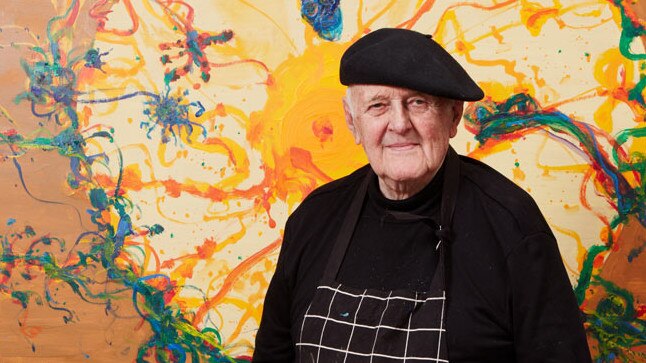
John Olsen was one of the greatest Australian painters of the 20th century. He came into prominence in the 1960s when Australian art underwent a renaissance of creativity. By then the battle for modern art had been won and the younger generation could experiment and follow new directions.
He belonged to a gifted group of painters, all born in 1927 or 1928, that included Fred Williams, Charles Blackman, Lawrence Daws, Leonard French and Robert Juniper, who all contributed to the change that occurred in Australia’s cultural history in the wake of their immediate predecessors: William Dobell, Russell Drysdale and Sidney Nolan. It was an amazing flowering of talent, producing a daring and enthusiastic new vision of Australia.
Olsen was well placed in Sydney, the city that inspired him and that he would continue to celebrate. Betty O’Neill’s 1964 Hungry Horse Gallery Calendar, which shows Olsen and a group of Sydney artists leaning over the balcony of what became Lucio’s Restaurant in Paddington, captures a moment of that exceptional period of Australian art. Lucio’s was a place where Olsen would spend much of his time over the decades, enjoying convivial time, entertaining friends and even designing the menus.
Born in Newcastle in 1928, Olsen moved with his family to Bondi in 1935. He was sent as a boarder to St Joseph’s College at Hunters Hill, where he first attended art classes. He recalled that a young Lloyd Rees came to talk to the class.
Family circumstances did not allow any further education and soon after leaving St Joseph’s he left home intending to become an artist. He attended various art classes, funding his activities by cleaning offices, which he continued up to the day before he left Sydney for Europe.
He attended classes with Dattilo Rubbo and Desiderius Orban, but the most important art training and early direction came at the Julian Ashton School (1950-53), where his teacher was John Passmore, recently returned from England where he had spent the war years. Passmore was an inspiring teacher who passed his great love for Cezanne to his students as well as a serious ethic about the art of painting. Olsen would joke that Passmore “tortured me with Cezanne”. He later attended classes at East Sydney Tech, with Passmore and Godfrey Miller.

In Sydney Olsen mixed with a group of artists with similar ideas, including William Rose, Eric Smith, Robert Klippel and occasionally the solitary Passmore. In 1953 they saw the important exhibition French Painting Today, which toured the state galleries, bringing new ideas to the still restricted knowledge of contemporary European art available in Australia. But it was the 1956 Italian Art of the 20th Century that created a more vigorous jolt to the young painters who by then were more ready to absorb fresh ideas. Olsen responded particularly to Mario Sironi and Renato Guttuso.
Olsen held his first one-man exhibition at the Macquarie Galleries in 1955 and the following year he arranged a short-lived but much talked about exhibition, Direction I, in December 1956 that is seen as an important moment in the move to abstraction. The artists included besides Olsen were Rose, Smith, Klippel and Passmore.
Paul Haefliger, The Sydney Morning Herald art critic, took an interest in these young painters and especially Olsen. He persuaded a business friend who was thinking of providing a private scholarship to a young painter to offer it to Olsen to enable him to travel overseas for three years. The businessman was to receive paintings by Olsen in return, but it was a great opportunity for the artist.
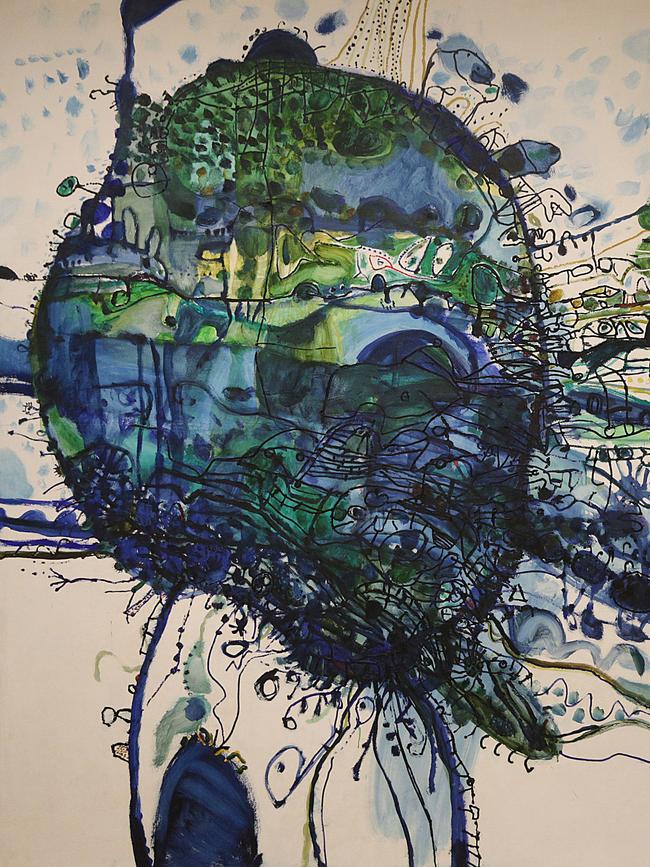
After landing in London, Olsen went on to Paris where Sydney painter and printmaker Earle Backen introduced him to William Hayter’s studio Atelier 17, which had revolutionised modern printmaking and where Olsen mastered that art.
From Paris Olsen went to Spain, spending much of his time there, most of it in Deya, Majorca where he met poet Robert Graves. He even performed a play, The Life and Death of Ned Kelly for Graves’s birthday party. In Spain Olsen began to keep a journal, which he kept up for the rest of his life. (An edited version was published as Drawn from Life in 1997.)
During a trip back to London in 1958 he met up with Drysdale and Haefliger, and during a visit to the famous Collins music hall, he met Williams, then painting and drawing music hall subjects. They would later become friends.
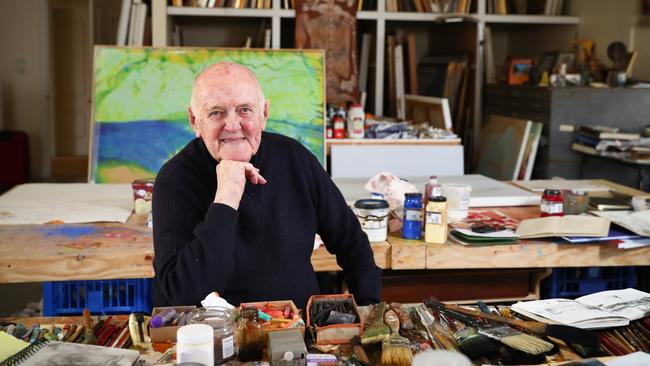
Olsen had an inquisitive mind and educated himself. He was an avid reader, especially of poetry. Even in the early 1950s his paintings bear the titles from the poets he was reading,
TS Eliot, Dylan Thomas, William Butler Yeats and his beloved Gerard Manley Hopkins. Olsen was one of the most widely read of Australian painters with an amazingly alert mind. He was probably equal to the other two great bibliophiles, James Gleeson and Nolan.
Having steeped himself in all that Spain could offer in art, life and food, Olsen returned to Sydney in 1960.
He brought back with him knowledge of European artists such as those of the CoBrA group, as well as Pierre Alechinsky, Jean Dubuffet and Antoni Tapies.
He was a much more confident painter on his return and filled with creative energy. Almost immediately he produced one of his most memorable paintings Spanish Encounter, which greatly enhanced his reputation, when it was exhibited at the Clune Galleries in 1961.
Looking out at Sydney from his studio in Victoria Street, Potts Point, Olsen said: “I want to get it all down.”

His immense visual appetite and unbounded energy led to some exceptional paintings: The Seaport series followed by the You Beaut Country series of the 1960s, which with their joyful vision and exuberant handling of paint led to him being seen as the painter of the Australian landscape.
His exploration of the means of expression and the intensity of his feelings poured life into his paintings.
In 1966 Olsen made another trip overseas. He first visited New York and later was joined by his second wife, Valerie, and their two small children, Tim and Louise. He went on to France to visit the tapestry workshop at Aubusson in France. (Olsen designed several tapestries woven in France and Portugal.)
Driving in France, on the way to Spain, they were involved in a car crash where they were all seriously injured. Tim had concussion and was unconscious for two days. Despite the accident and Olsen’s broken arm, they continued on to Spain as Olsen was determined that the children and Valerie should experience Spain.
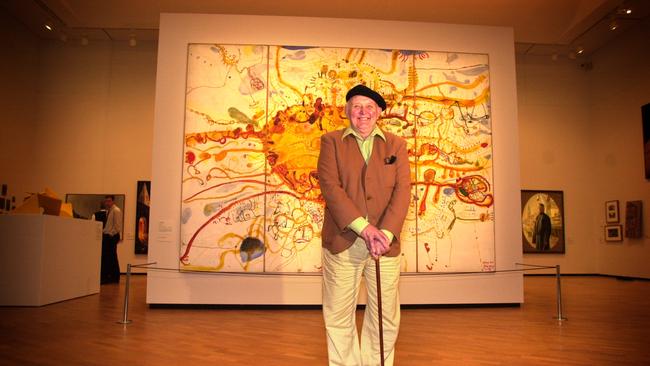
Spain remained an important influence in Olsen’s life, and after another trip there in 1985 he painted a series of Spanish-inspired works that are among the most joyful and intense of his later works: rich in colour, texture and contrasts.
The originality of Olsen’s vision made the critics take notice of him and by the late 1960s his reputation was assured.
In 1970, the Dobell Foundation, whose director was painter and art critic Gleeson, commissioned Olsen to paint a large mural for the Sydney Opera House. It measures about 3.05m x 21.3m and is one of the artistic wonders of Sydney. Its subject is a nocturne of Sydney Harbour, inspired by Kenneth Slessor’s poem Five Bells. The mural took three years to complete and might be seen as the culmination of Olsen’s relationship with Sydney and urban life.
In 1974 Olsen went with Vincent Serventy to Lake Eyre. The experience made a lasting impression on the artist and enriched his spiritual life. Flying over the lake was a revelation for him. “Landscape can only be seen in its proper proportions from the air, it is so vast,” he commented. Some of Olsen’s most lyrical and beautiful large watercolours resulted from this trip. Painted on large sheets of Japanese paper, they measure up to 2m in height.
Active, mercurial and in need of new experiences and stimulation for his creativity, in 1981 Olsen moved to Clarendon, South Australia, now married for the third time, to Noela Hjorth.
In 1989 Olsen married his fourth wife, Katharine, and they went to live in the Blue Mountains, later moving to Rydal in NSW, and eventually to Bowral, to a grand property, suitable for Katharine’s horses, and where he could paint undisturbed.
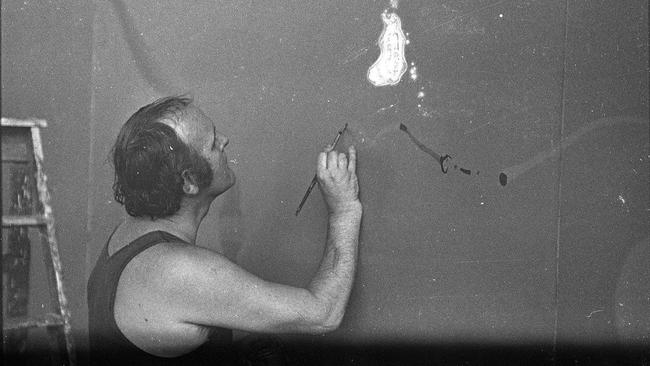
In 1991 Olsen was justly honoured by a retrospective of his work organised by the National Gallery of Victoria (not Sydney where he had served on the Art Gallery board). It was curated by Deborah Hart, who wrote the definitive monograph on his work.
During the last two decades of his life Olsen became the grand old man of Australian art, his work much in demand. In 2013 he was commissioned to paint the largest work he had ever attempted, King Sun, measuring 6m x 8m, for Walker Corporation at Collins Square, Melbourne.
His honours include an AO, an OBE awarded in 1977 and an Australian Creative fellowship in 1993. He won the Wynne Prize twice in 1969 and 1985, and the Archibald Prize with Self-portrait: Janus Faced in 2005.
His fourth wife, Katharine, died in 2016, after 27 years of marriage. After her death he was entangled in a court case over money given to Karen Mentink, Katharine’s daughter. Olsen took his estranged stepdaughter to the NSW Supreme Court in 2019 seeking to recover a $2.2m cash gift procured by Mentink from her terminally ill mother in 2016. The court ruled in Olsen’s favour and the decision was upheld by the Court of Appeal in 2020.
Olsen is survived by his son Tim (of Olsen Gallery) and daughter Louise (of Dinosaur Designs), the children of his second wife Valerie, who died in 2011. Jane, his daughter from his first marriage in 1951 to Mary Flower, died in 2009.
Lou Klepac is an art historian.

To join the conversation, please log in. Don't have an account? Register
Join the conversation, you are commenting as Logout